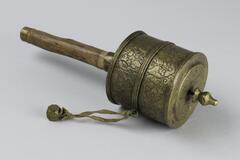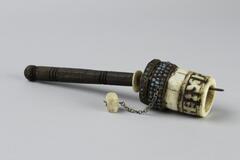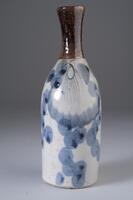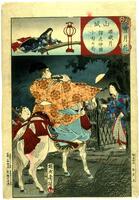59 UMMA Objects
59 UMMA Objects

Tibetan (Tibetan (culture or style))
Prayer Wheel (Mani Wheel)
1833 – 1932
Gift of the Estate of Maxine W. Kunstadter in memory of Sigmund Kunstadter, Class of 1922
1983/1.423

Tibetan (Tibetan (culture or style))
Prayer Wheel (Mani Wheel)
1833 – 1932
Gift of the Estate of Maxine W. Kunstadter in memory of Sigmund Kunstadter, Class of 1922
1983/1.424

Chinese (Chinese (culture or style))
Round Embroidery
1867 – 1932
Gift of Mr. and Mrs. Herbert W. Johe
1989/2.77

Zu Ze (Tsu-tse)
Both sides: Calligraphy
1867 – 1932
Museum Purchase made possible by the Richard K. Beardsley Memorial Fund, supplemented by the Friends of the Museum of Art
1980/1.230

Ni Tian
Tao Yuanming Appreciating Chrysanthemums
1855 – 1919
Gift of Jung Ying Ts'ao, in honor of State Senator Jack Faxon
1987/1.275

Chinese (Chinese (culture or style))
Round Embroidery
1867 – 1932
Gift of Mr. and Mrs. Herbert W. Johe
1989/2.75

Japanese (Japanese (culture or style))
Small Sake Tokuri or Vase
1867 – 1932
Gift of Ann Holmes
2013/1.332
Thai
Candlestick (one of a pair)
1800 – 1932
Gift of Doris Duke's Southeast Asian Art Collection
2005/1.471.1

Toyohara Chikanobu (Japanese (culture or style))
Setsugekka [Snow, Moon and Flowers]: Yamashiro, Moon over Saga
1867 – 1932
Gift of Pearl Sellards
1985/1.177
![A corn husk woven basket with wooden shaping dowels. One side of the rectangle is flat while the other end is curved. There are two blue stripes on the inside floor of the basket and green and purple designs on the outside.<br />
<br />
This straw basket (<em>samtaegi</em> ) is woven from dyed straw. The round frame at the back of it is made from bitterwood and the front part from bamboo. Judging from the use of dyed straw, this basket was probably used for drying grain such as soy beans.
<p>[Korean Collection, University of Michigan Museum of Art (2017) p. 277]</p>
A corn husk woven basket with wooden shaping dowels. One side of the rectangle is flat while the other end is curved. There are two blue stripes on the inside floor of the basket and green and purple designs on the outside.<br />
<br />
This straw basket (<em>samtaegi</em> ) is woven from dyed straw. The round frame at the back of it is made from bitterwood and the front part from bamboo. Judging from the use of dyed straw, this basket was probably used for drying grain such as soy beans.
<p>[Korean Collection, University of Michigan Museum of Art (2017) p. 277]</p>](/media/W1siZiIsIjIwMjIvMDkvMjQvZmVlMTZ2YW0yX2RlZmF1bHQuanBnIl0sWyJwIiwidGh1bWIiLCIyNDB4MjAwIl1d?sha=63e41f30e2d00ee4)
Korean (Korean (culture or style))
Winnowing Basket
1850 – 1950
Gift of Ok Ja Chang and the Chang Family
2009/2.49
Loading…


